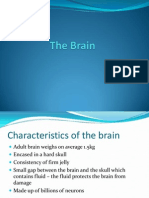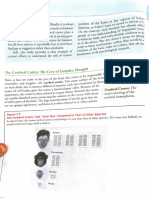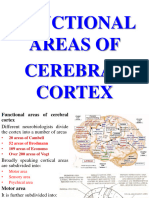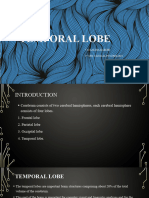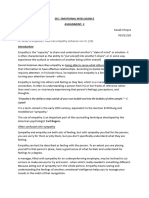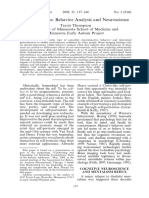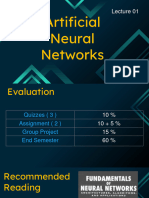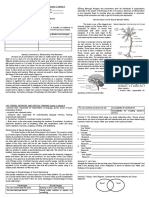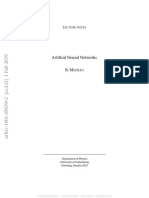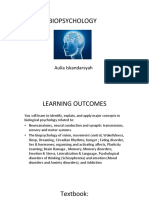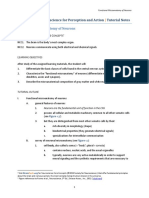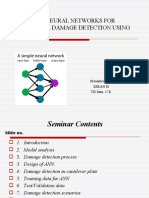Q.
Explain types of lobes
Lobes:
Neuroscientists rely on a combination of anatomical landmarks and functional
differences to distinguish among four major cortical regions:
frontal, parietal, temporal, and occipital lobes
These lobes, named after the bones of the skull that overlie them.
In some cases, the boundaries between adjacent lobes are very clear; for example,
the Sylvian fissure (a deep sulcus) divides the temporal lobe (just beside your temple)
from the other regions of the hemisphere.
Likewise, the central sulcus provides a distinct landmark dividing the frontal and
parietal lobes. The physical boundaries between the occipital lobe and the temporal
and parietal lobes are less obvious, but the lobes are quite different with regard to the
functions they perform.
Lobe is a functional unit, having one set of functions.
The main function of the occipital lobes is quite straightforward: We humans rely
heavily on the analysis of visual input to guide our behavior, and the occipital cor tex
and large areas of adjacent cortex perform this function.
There are two large functional areas in each parietal lobe: The postcentral gyrus
analyzes sensations from the body (e.g., touch), whereas the remaining areas of
cortex in the posterior parts of the parietal lobes play roles in perceiving the location
of both objects and our own bodies and in directing our attention.
The cortex of each tempo ral lobe has three general functional areas: The superior
temporal gyrus is involved in hearing and language, the inferior temporal cortex
identifies complex visual patterns, and the medial portion of temporal cortex (which is
not visible from the usual side view) is important for certain kinds of memory.
Lastly, each frontal lobe has two distinct functional areas: The precentral gyrus and
adjacent frontal cortex have a motor function, whereas the frontal cortex anterior to
motor cortex performs complex cognitive func tions, such as planning response
sequences, evaluating the outcomes of potential patterns of behavior, and assess ing
the significance of the behavior of others.
https://clinictocommunity.ca/wp-content/uploads/2021/01/LobesOfTheBrain.pdf
Introduction
The cerebral cortex is a part of the brain that functions to make human beings unique.
Distinctly human traits including higher thought, language, human consciousness, as
well as the ability to think, reason, and imagine all originate in the cerebral cortex.
The cerebral cortex is what we see when we look at the brain. It is the outermost
portion that can be divided into the four lobes of the brain. Each bump on the surface
of the brain is known as a gyrus, while each groove is known as a sulcus.
� The cerebral cortex can be divided into four sections, which are known as lobes. The
frontal lobe, parietal lobe, occipital lobe and temporal lobe. These lobes have been
associated with different functions ranging from reasoning to auditory perception.
1. Frontal Lobe
Location:
The frontal lobe is an area in the brain of humans and other mammals, located at the
front of each cerebral hemisphere and positioned anterior to (in front of) the parietal
lobes and above and anterior to the temporal lobes.
It is separated from the parietal lobe by the post-central gyrus primary motor cortex,
which controls voluntary movements of specific body parts associated with the
precentral gyrus posteriorly.
Functions:
This section reaches maturity when a person is about 25 years old. It handles the
functions of planning, emotions, and parts of speech.
It is associated with reasoning, motor skills, higher lever cognition, and expressive
language. It is also where most of the personality is based. This means that it controls
a lot of a person’s behaviour and expressions.
This area of the brain receives information from various lobes of the brain and utilises
this information to carry out body movements.
The executive functions of the frontal lobes:
involve the ability to recognise future consequences resulting from current actions, to
choose between good and bad actions, override and suppress unacceptable social
responses, and determine similarities and differences between things or events.
Therefore, it is involved in higher mental functions.
Asymmetrical differences in the frontal lobes:
The left frontal lobe is involved in controlling language related movement, whereas
the right frontal lobe plays a role in non verbal abilities.
Psychological tests that measure frontal lobe function include finger tapping,
Wisconsin Card Sorting Task, and measures of verbal and figural fluency.
Damage:
Patients with frontal lobe damage exhibit little spontaneous facial expression,
which points to the role of the frontal lobes in facial expression. Broca’s Aphasia,
or difficulty in speaking, has been associated with frontal lobe damage.
Another area often associated with frontal damage is that of “behavioural
sponteneity.” It has been noted that individual with frontal lobe damage
displayed fewer spontaneous facial movements, spoke fewer words (left frontal
lesions) or excessively (right frontal lesions).
One of the most common effects of frontal lobe damage can be a dramatic
change in social behaviour. A person’s personality can undergo significant
� changes after an injury to the frontal lobes, especially when both lobes are
involved.
2. Parietal Lobe
Location:
The parietal lobe above the occipital lobe and behind the frontal lobe.
It is located in the middle section of the brain and is associated with processing tactile
sensory information.
Function:
This part of the cerebellum handles information related to touch, temperature, pain
and pressure.
This lobe coordinates sensory information and enables the person to correctly
perceive their environment as one complete whole.
The parietal lobe can be divided into two functional regions.
• One involves sensation and perception and the other is concerned with integrating
sensory input, primarily with the visual system.
• The first function integrates sensory information to form a single perception
(cognition).
• The parietal lobe plays important roles in integrating sensory information from
various parts of the body, knowledge of numbers and their relations and in the
manipulation of objects.
• The second function constructs a spatial coordinate system to represent the world
around us.
• Individuals with damage to the parietal lobes often show striking deficits, such as
abnormalities in body image and spatial relations.
Damage:
If this area is damaged, a person may have difficulty with coordination, movement or
recognition that his or her body is in pain.
Damage to the left parietal lobe can result in what is called “Gerstmann’s Syndrome.”
It includes right-left confusion, difficulty with writing (agraphia) and difficulty with
mathematics (acalculia). It can also produce disorders of language (aphasia) and the
inability to perceive objects normally (agnosia).
Damage to the right parietal lobe can result in neglecting part of the body or space
(contralateral neglect), which can impair many self-care skills such as dressing and
washing.
3. Temporal Lobe
Location:
The temporal lobe is a region of the cerebral cortex that is located beneath the
Sylvian fissure on both cerebral hemispheres of the mammalian brain.
�The temporal lobe is located on the side of the cerebrum and at the bottom section of
the brain. This lobe is also the location of the primary auditory cortex, which is
important for interpreting sounds and the language we hear.
The hippocampus is also located in the temporal lobe, which is why this portion of the
brain is also heavily associated with the formation of memories.
Function:
The main purpose of this lobe is to interpret auditory data. This means that it
processes information that a person receives through their sense of hearing.
This lobe also plays a role in both speech and memory. It is believed that the temporal
lobe helps when the brain is transferring memories from short term to long term.
The underside (ventral) part of the temporal cortices appear to be involved in high-
level visual processing of complex stimuli such as faces (fusiform gyrus) and scenes
(parahippocampal gyrus). Anterior parts of this ventral stream for visual processing
are involved in object perception and recognition.
The medial temporal lobes (near the Sagittal plane that divides left and right cerebral
hemispheres) are thought to be involved in episodic/declarative memory. Deep inside
the medial temporal lobes lie the hippocampi, which are essential for memory
function that is particularly the transference from short to long term memory and
control of spatial memory and behaviour.
Damage:
Kolb & Wishaw (1990) have identified eight main symptoms of temporal lobe damage:
1) Disturbance of auditory sensation and perception,
2) Disturbance of selective attention of auditory and visual input,
3) Disorders of visual perception,
4) Impaired organisation and categorisation of verbal material,
5) Disturbance of language comprehension,
6) Impaired long-term memory,
7) Altered personality and affective behaviour,
8) Altered sexual behaviour.
4.Occipital Lobe
Location:
Located in the rearmost portion of the skull, the occipital lobes are part of the
forebrain.
the occipital lobe is defined as the part of the cerebral cortex that lies underneath the
occipital bone.
Function:
�The occipital lobe is the part of the brain that manages data received through the
sense of vision. This lobe is located behind and below the parietal and temporal lobes.
This part of the brain allows us to distinguish shapes and colours and to process what
our eyes see. The primary visual cortex, which receives and interprets information
from the retinas of the eyes, is located in the occipital lobe.
The most important functional aspect of the occipital lobe is that it contains the
primary visual cortex.
Each visual cortex receives raw sensory information from the outside half of the retina
on the same side of the head and from the inside half of the retina on the other side of
the head.
Damage:
Damage to one side of the occipital lobe causes homonomous loss of vision with
exactly the same “field cut” in both eyes.
Disorders of the occipital lobe can cause visual hallucinations and illusions.
Visual hallucinations (visual images with no external stimuli) can be caused by lesions
to the occipital region or temporal lobe seizures.
Visual illusions (distorted perceptions) can take the form of objects appearing larger or
smaller than they actually are, objects lacking color or objects having abnormal
coloring.
Q. Explain neuron and describe action potential
Introduction
Neuron- nerve cell is the information processing and information-transmitting element
of the nervous system. neurons are cells that are specialized for the reception,
conduction, and transmission of electrochemical signals.
The neuron has four structural divisions specialized for information processing:
1. Cellular extensions called dendrites (from the Greek dendron, “tree”) serve as an
input zone, receiving information from other neurons across synapses. Dendrites may
be elaborately branched to accommodate synapses from many other neurons.
2. The cell body (or soma, plural somata) contains the cell’s nucleus. In addition to
receiving additional synaptic inputs, the cell body serves as an integration zone,
combining (integrating) the information that the neuron has received to determine
whether or not to send a signal of its own.
3. A single extension, the axon, leads away from the cell body and serves as a
conduction zone, carrying the cell’s own electrical signals away from the cell body.
Before its end, the axon may split into multiple branches called axon col laterals.
4. Specialized swellings at the ends of the axon, called axon terminals (or synap tic
boutons), are a functional output zone. They transmit the neuron’s activity across
synapses to other cells.
Types of Neurons-
�On the basis of shape:
1. Multipolar neurons have many dendrites and a single axon, and they are the most
common type of neuron
2. Bipolar neurons have a single dendrite at one end of the cell and a single axon at
the other end. This type of neuron is especially common in sensory systems, such as
vision.
3. Unipolar neurons (also called monopolar) have a single extension (or process),
usually thought of as an axon, that branches in two directions after leaving the cell
body. One end is the input zone with branches like dendrites; the other, the out put
zone. Such cells transmit touch information from the body into the spinal cord.
On the basis of function:
1. Motor neurons
Motor neurons (or motoneurons)—the neurons that govern movements—have long
axons reaching out to synapse on muscles, caus ing them to contract in response to
commands from the brain.
2. Sensory neurons
The long axons of sensory neu rons carry messages from the periphery back to the
spinal cord and brain. Sensory neurons take many different shapes, depending on
whether they detect light or sound or touch and so on.
3. Interneurons
the great majority of neurons, making up most of the brain, are classified as
interneurons. These are the neurons that receive information from other neurons,
process it, and pass the integrated information to other neurons. Interneurons make
up the hugely complex networks and circuits that perform the complex functions of
the brain.
ACTION POTENTIAL





































